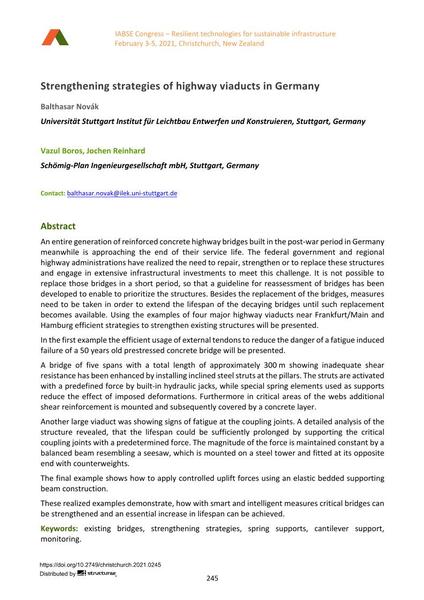Strengthening strategies of highway viaducts in Germany

|
|
|||||||||||
Bibliographic Details
| Author(s): |
Balthasar Novák
(Universität Stuttgart Institut für Leichtbau Entwerfen und Konstruieren, Stuttgart, Germany)
Vazul Boros (Schömig-Plan Ingenieurgesellschaft mbH, Stuttgart, Germany) Jochen Reinhard (Schömig-Plan Ingenieurgesellschaft mbH, Stuttgart, Germany) |
||||
|---|---|---|---|---|---|
| Medium: | conference paper | ||||
| Language(s): | English | ||||
| Conference: | IABSE Congress: Resilient technologies for sustainable infrastructure, Christchurch, New Zealand, 3-5 February 2021 | ||||
| Published in: | IABSE Congress Christchurch 2020 | ||||
|
|||||
| Page(s): | 245-260 | ||||
| Total no. of pages: | 16 | ||||
| DOI: | 10.2749/christchurch.2021.0245 | ||||
| Abstract: |
An entire generation of reinforced concrete highway bridges built in the post-war period in Germany meanwhile is approaching the end of their service life. The federal government and regional highway administrations have realized the need to repair, strengthen or to replace these structures and engage in extensive infrastructural investments to meet this challenge. It is not possible to replace those bridges in a short period, so that a guideline for reassessment of bridges has been developed to enable to prioritize the structures. Besides the replacement of the bridges, measures need to be taken in order to extend the lifespan of the decaying bridges until such replacement becomes available. Using the examples of four major highway viaducts near Frankfurt/Main and Hamburg efficient strategies to strengthen existing structures will be presented. In the first example the efficient usage of external tendons to reduce the danger of a fatigue induced failure of a 50 years old prestressed concrete bridge will be presented. A bridge of five spans with a total length of approximately 300 m showing inadequate shear resistance has been enhanced by installing inclined steel struts at the pillars. The struts are activated with a predefined force by built-in hydraulic jacks, while special spring elements used as supports reduce the effect of imposed deformations. Furthermore in critical areas of the webs additional shear reinforcement is mounted and subsequently covered by a concrete layer. Another large viaduct was showing signs of fatigue at the coupling joints. A detailed analysis of the structure revealed, that the lifespan could be sufficiently prolonged by supporting the critical coupling joints with a predetermined force. The magnitude of the force is maintained constant by a balanced beam resembling a seesaw, which is mounted on a steel tower and fitted at its opposite end with counterweights. The final example shows how to apply controlled uplift forces using an elastic bedded supporting beam construction. These realized examples demonstrate, how with smart and intelligent measures critical bridges can be strengthened and an essential increase in lifespan can be achieved. |
||||
| Keywords: |
existing bridges monitoring strengthening strategies spring supports cantilever support
|
||||
